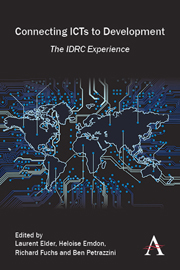Book contents
- Frontmatter
- Contents
- Acknowledgments
- Introduction Part I From Heresy to Orthodoxy: ICT4D at IDRC
- Introduction Part II From Beginning to End to Beginning Again
- Chapter 1 Catalyzing Access through Social and Technical Innovation
- Chapter 2 Catalyzing Access via Telecommunications Policy and Regulatory Research
- Chapter 3 Access to Knowledge as a New Paradigm for Research on ICTs and Intellectual Property
- Chapter 4 ICTs and Social Inclusion
- 5 Access and Usage of ICTs by the Poor (Part I)
- Chapter 6 Local Economic Opportunities and ICTs: How ICTs Affect Livelihoods (Part II)
- Chapter 7 Research on eHealth across Health Systems: Contributions to Strengthen a Field
- Chapter 8 Making the Grade: The Role of ICTs in Providing Access to Knowledge
- Chapter 9 E-Government for Development: ICTs in the Public Sector and the Evolving Citizen–Government Relationship
- Chapter 10 Innovations in Evaluating ICT4D Research
- Chapter 11 Conclusions: A Decade of Innovation that Matters
- Epilogue Into the Future: New Opportunities and Threats in a Global Networked Society
- Author Biographies
Chapter 6 - Local Economic Opportunities and ICTs: How ICTs Affect Livelihoods (Part II)
from Introduction Part II - From Beginning to End to Beginning Again
Published online by Cambridge University Press: 05 March 2014
- Frontmatter
- Contents
- Acknowledgments
- Introduction Part I From Heresy to Orthodoxy: ICT4D at IDRC
- Introduction Part II From Beginning to End to Beginning Again
- Chapter 1 Catalyzing Access through Social and Technical Innovation
- Chapter 2 Catalyzing Access via Telecommunications Policy and Regulatory Research
- Chapter 3 Access to Knowledge as a New Paradigm for Research on ICTs and Intellectual Property
- Chapter 4 ICTs and Social Inclusion
- 5 Access and Usage of ICTs by the Poor (Part I)
- Chapter 6 Local Economic Opportunities and ICTs: How ICTs Affect Livelihoods (Part II)
- Chapter 7 Research on eHealth across Health Systems: Contributions to Strengthen a Field
- Chapter 8 Making the Grade: The Role of ICTs in Providing Access to Knowledge
- Chapter 9 E-Government for Development: ICTs in the Public Sector and the Evolving Citizen–Government Relationship
- Chapter 10 Innovations in Evaluating ICT4D Research
- Chapter 11 Conclusions: A Decade of Innovation that Matters
- Epilogue Into the Future: New Opportunities and Threats in a Global Networked Society
- Author Biographies
Summary
With the growing reach of mobile telephony, an inquiry into how information and communications technologies (ICTs) affect the livelihoods of the poor may seem unnecessary in the second decade of the twenty-first century. People all over the world, and especially in the developing world, are now “voting with their wallets” and paying to adopt mobile telecommunications technology in their business, personal and educational lives. When the “Information and Communications Technologies for Development” (ICT4D) program at the International Development Research Centre (IDRC) was first introduced in 2000, mobile phones were far from being the “everywhere” technology they have since become. Like the Internet, mobile phones in the developing world were – and, in some cases, still are – prestige technologies available only at a premium price. What role could they possibly have in helping peasant farmers and micro-entrepreneurs make more money and develop more productive enterprises? This chapter continues the discussion in the earlier chapter on ICTs and poverty, but focuses more squarely on the role of ICTs as tools of productivity for farmers and small entrepreneurs.
Applied research within the ICT4D program at IDRC understood that social policy programs were a necessary, but not necessarily sufficient tool for lowering levels of poverty in a country over the long term. Other complementary approaches, such as building economic opportunities for the poor in targeted and focused ways, were equally important, especially in a developing country's poverty reduction strategies.
- Type
- Chapter
- Information
- Connecting ICTs to DevelopmentThe IDRC Experience, pp. 137 - 160Publisher: Anthem PressPrint publication year: 2013



